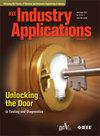Turn to Turn Short-Circuit Fault and High-Resistance Connection Diagnosis for Induction Motor During Start-Up Transient
IF 4.2
2区 工程技术
Q2 ENGINEERING, ELECTRICAL & ELECTRONIC
引用次数: 0
Abstract
In this paper, a new method to diagnose turn-to-turn short-circuit faults (TSCFs) and high-resistance connections (HRCs) for soft-starters fed squirrel cage-rotor induction motors (IMs) is proposed. TSCF and HRC faults cause a significant temperature increase if not early detected. TSCFs requires immediate IM shutdown, whereas the effects of HRCs can be monitored over time. Several methods proposed in the literature are based on zero-sequence voltage or negative-sequence current for fault diagnosis. Most of them were applied for steady-state conditions and only consider sinusoidally distributed windings, without including harmonic components. The proposed method is based on monitoring the fifth harmonic current during the start-up transient to separate the effects of TSCFs and HRCs. Two new analytical models with fault considering the感应电动机起动瞬态匝间短路故障及高阻连接诊断
提出了一种诊断软起动鼠笼转子异步电动机匝间短路故障和高阻连接故障的新方法。如果不及早发现,TSCF和HRC故障会导致显著的温度升高。TSCFs需要立即关闭IM,而hrc的影响可以随着时间的推移而监测。文献中提出了几种基于零序电压或负序电流的故障诊断方法。它们大多应用于稳态条件,只考虑正弦分布的绕组,不包括谐波分量。该方法基于对启动瞬态过程中五次谐波电流的监测,以分离tscf和hrc的影响。提出了考虑供电电压h次谐波的两种新的故障分析模型。第一个IM模型包含了任何相位绕组中TSCF的影响,而第二个模型考虑了HRC故障。在此分析模型的基础上,提出了两个指标来量化断层的严重程度。这两个指标都是从定子电流的正序分量定义的,并允许分离tscf和hrc之间的影响。在不修改其控制算法和内部结构的情况下,使用标准软启动器进行了实际实现。在实验测试中,使用改进绕组的IM产生3到10圈之间的短路。另一方面,hrc是由不同大小的电阻串联在一个相绕组上产生的。实验结果表明,在TSCF和HRC存在下,五次谐波的正序电流分量呈现出不同的模式。
本文章由计算机程序翻译,如有差异,请以英文原文为准。
求助全文
约1分钟内获得全文
求助全文
来源期刊

IEEE Transactions on Industry Applications
工程技术-工程:电子与电气
CiteScore
9.90
自引率
9.10%
发文量
747
审稿时长
3.3 months
期刊介绍:
The scope of the IEEE Transactions on Industry Applications includes all scope items of the IEEE Industry Applications Society, that is, the advancement of the theory and practice of electrical and electronic engineering in the development, design, manufacture, and application of electrical systems, apparatus, devices, and controls to the processes and equipment of industry and commerce; the promotion of safe, reliable, and economic installations; industry leadership in energy conservation and environmental, health, and safety issues; the creation of voluntary engineering standards and recommended practices; and the professional development of its membership.
 求助内容:
求助内容: 应助结果提醒方式:
应助结果提醒方式:


